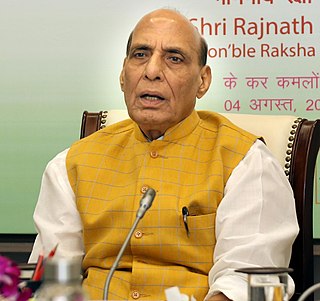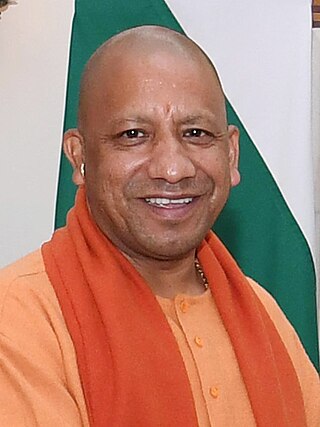
An animal shelter or pound is a place where stray, lost, abandoned or surrendered animals – mostly dogs and cats – are housed. The word "pound" has its origins in the animal pounds of agricultural communities, where stray livestock would be penned or impounded until they were claimed by their owners.
Tiruvallur district, also spelled as Thiruvallur district, is one of the 38 districts in the Indian state of Tamil Nadu. The fast developing city of Tiruvallur is the district headquarters. The district has a mixture of urban and rural characteristics. The eastern part of Tiruvallur district is dominated by urban characteristics while the Northern part of the district has influence of Andhra culture due to its position. In 2011, the district had a population of 3,728,104 with a sex-ratio of 987 females for every 1,000 males.

Tiruvallur is a Grade I municipality in the Indian state of Tamil Nadu. It is located on the banks of Coovum river about 46 km (29 mi) from downtown Chennai (Madras) and just 5 km from megacity border, in the western part of the Chennai Metropolitan Area (CMA). It is a satellite town of Chennai and is the administrative headquarters of Tiruvallur District. The town is known for the Veeraraghava Swamy Temple, one of the 108 sacred shrines of Vaishnavites. The tank festival is held at a pond near this temple. A Shiva temple near this shrine which is popular among the locals. There is also a 40-foot (12 m) tall Viswaroopa Panchamukha Hanuman temple, where the murti is made of a single green granite stone.

The Gorakhnath Math, also known as Gorakhnath Temple or Shri Gorakhnath Mandir, is a temple of the Nath monastic order group of the Nath tradition. The name Gorakhnath derives from the medieval saint, Gorakshanath, a yogi who travelled widely across India and authored a number of texts that form a part of the canon of Nath Sampradaya. The Nath tradition was founded by guru Matsyendranath. This math is situated in Gorakhpur, Uttar Pradesh, India within large premises. The temple performs various cultural and social activities and serves as the cultural hub of the city.

Ayodhya district is one of the 75 districts in the northern Indian state of Uttar Pradesh. The city of Ayodhya is its administrative headquarters. The district occupies an area of 2,522 square kilometres (974 sq mi), and had a population of 2,470,996 in the 2011 census. Ayodhya district shares its borders with 6 districts of Uttar Pradesh. It is bordered by Gonda and Basti districts on the northern side, Amethi and Sultanpur districts on the south, and Ambedkar Nagar and Barabanki districts share the border on the east and west.

Yogi Adityanath is an Indian Hindu monk and politician, belonging to the Bharatiya Janata Party who has been serving as the Chief Minister of Uttar Pradesh since 19 March 2017. He is the longest serving chief minister of Uttar Pradesh, being in office for 7 years, and the only UP chief minister to have two consecutive terms.

Rajnath Singh is an Indian politician and lecturer, and the 25th Defence Minister of India since 2019. He was also the Deputy Leader of the House, Lok Sabha from 2019 to 2024. He was the 8th President of the Bharatiya Janata Party from 2005 to 2009 and again from 2013 to 2014. He is a veteran leader of the BJP who started his career as a swayamsevak of the Rashtriya Swayamsevak Sangh.

Sampurnanand was an Indian teacher and politician who served as the second Chief Minister of Uttar Pradesh from 1954 until 1960, and later as Governor of Rajasthan. Serving for five years and 344 days, he had the longest single tenure of any Uttar Pradesh Chief Minister until surpassed by Yogi Adityanath in 2023.

Kanpur Airport, is a domestic airport and an Indian Air Force base that serves the city of Kanpur in Uttar Pradesh, India. It is located at Chakeri, about 17 km (11 mi) from the city centre, and operates as a civil enclave within the Chakeri Air Force Station of the Indian Air Force. It provides connectivity to major tourist and historical attractions in the area such as Bithoor, Sankissa, Etawah Safari Park, Kalinjar Fort, Kalpi, National Chambal Sanctuary, Bhitargaon and Kannauj.

The Uttar Pradesh Police, is the primary law enforcement agency within the Uttar Pradesh state of India. Established in 1863 as the Office of the Inspector General of Police, United Provinces under the Police Act, 1861. It is headed by Director General of Police (DGP).

Gaushalas or Goshalas are protective shelters for stray cow in India. Government grants and donations are the primary source of income of the cow shelters in India. Since 2014, when BJP government came into power in India, India has spent ₹5.8 billion (US$69 million) on cow shelters in two years between 2014 and 2016.

Lalji Tandon was an Indian politician who served as the 18th Governor of Madhya Pradesh and 28th Governor of Bihar. He had also served as a member of parliament from 1996 until 2014 and as the Leader of the Opposition of the Legislative Assembly of Uttar Pradesh from 2003 until 2007. He was a member of Bharatiya Janata Party (BJP) and a protégé of Atal Bihari Vajpayee.
Stray animals are common on the runways of Indian airports. These stray animals pose a major threat to air safety in most airports across the nation. According to the Airports Authority of India (AAI) officials, animals straying onto the runway are routine at many airports in India.

Cattle slaughter in India, especially cow slaughter, is controversial because of cattle's status as endeared and respected living beings to adherents of Dharmic religions like Hinduism, Buddhism, Sikhism and Jainism. Also, many of the Zoroastrians/Parsis living in India stopped eating beef out of respect, as it is sacred for the people of Dharmic religions; while it is an acceptable source of meat in Abrahamic religions like Islam, Christianity and Judaism. Cow slaughter has been shunned for a number of reasons, specifically because of cow's association with Lord Krishna in Hinduism, and because cattle have been an integral part of rural livelihoods as an economic necessity. Cattle slaughter has also been opposed by various Indian religions because of the ethical principle of Ahimsa (non-violence) and the belief in the unity of all life. Legislation against cattle slaughter is in place throughout most states and territories of India.

Keshav Prasad Maurya is an Indian politician, currently serving as the Deputy Chief Minister of Uttar Pradesh. He is a member of the Bharatiya Janata Party. Maurya was associated with a right-wing Hindu organization Rashtriya Swayamsevak Sangh, before entering active politics through BJP. He was also involved in cow protectionism in his early life. Before 2017 Uttar Pradesh Legislative Assembly elections, he was made state president of the BJP, and after the victory of BJP, he was appointed as Deputy Chief Minister of Uttar Pradesh in the first Yogi Adityanath Government. Maurya again contested the legislative assembly elections in 2022 from Sirathu Assembly constituency, losing to Pallavi Patel of Samajwadi Party. However, he was given a second term as Deputy CM in the second Yogi Adityanath government.
Animal welfare and rights in India regards the treatment of and laws concerning non-human animals in India. It is distinct from animal conservation in India.
Chaudhary Laxmi Narayan Singh is an Indian politician and member of 9th, 13th, 15th and 17th Legislative Assembly of Uttar Pradesh. And currently serving as Minister of Dairy Development, Animal Husbandry, Fisheries in Yogi Adityanath ministry. He represents the Chhata constituency as a candidate of the Bharatiya Janata Party in the Uttar Pradesh Legislative Assembly. He was previously a member of the Bahujan Samaj Party and was a cabinet minister in the government led by chief minister Mayawati.
Friederike Irina Bruning, now called Sudevi Mataji, is a German animal rights activist. She was awarded India's fourth highest civilian award, the Padma Shri, She was the founder of Radha Surabhi Goshala in 1996. A German citizen, Sudevi Mataji has resided in Radha Kund (Vrindavan) for over 35 years, taking care of cows in need.

Legislative Assembly elections were held in Uttar Pradesh from 10 February to 7 March 2022 in seven phases to elect all 403 members for the 18th Uttar Pradesh Legislative Assembly. The votes were counted and the results were declared on 10 March 2022.

The 2024 Indian general election was held in Uttar Pradesh in seven phases from 19 April to 1 June to elect 80 members of the 18th Lok Sabha, with the results declared on 4 June. Bypolls for Dadraul, Lucknow East, Gainsari, and Duddhi assembly constituencies were held alongside this election.























